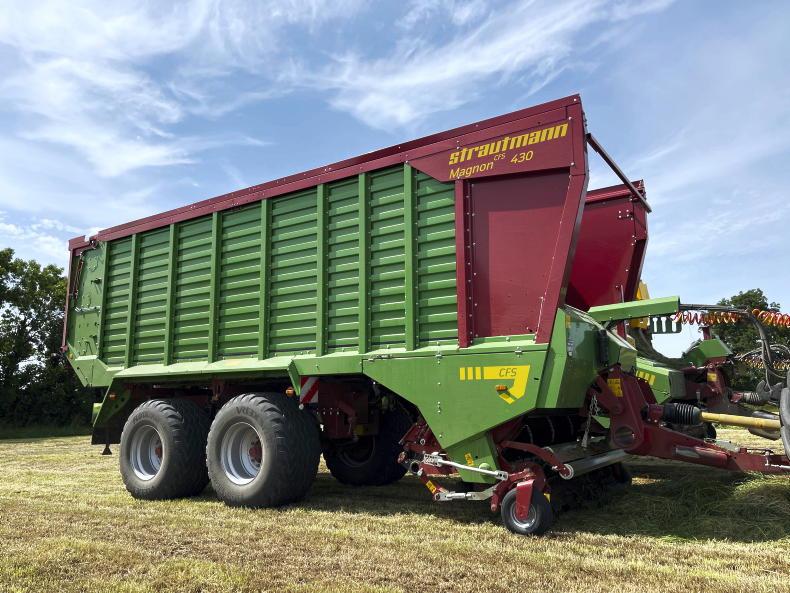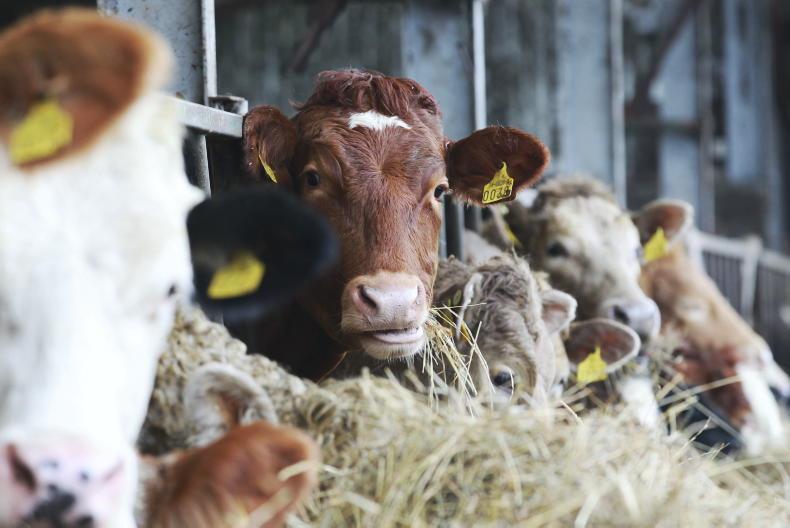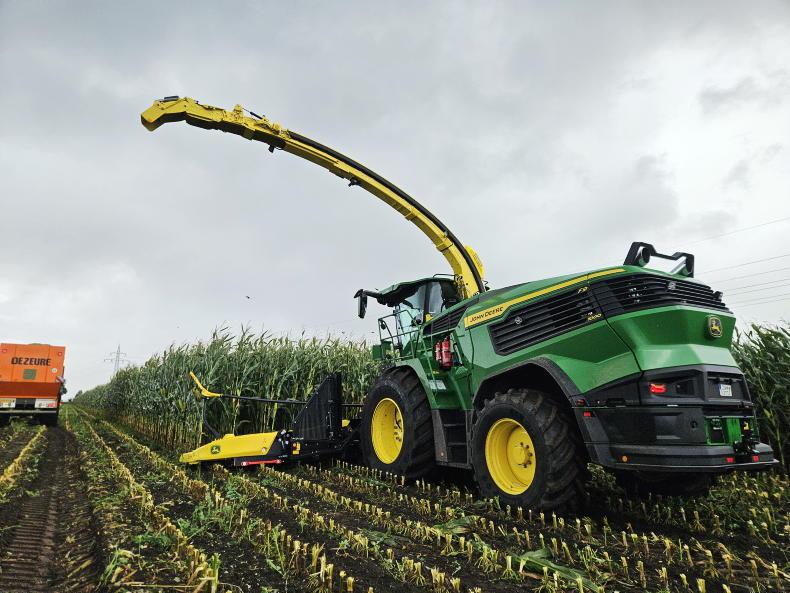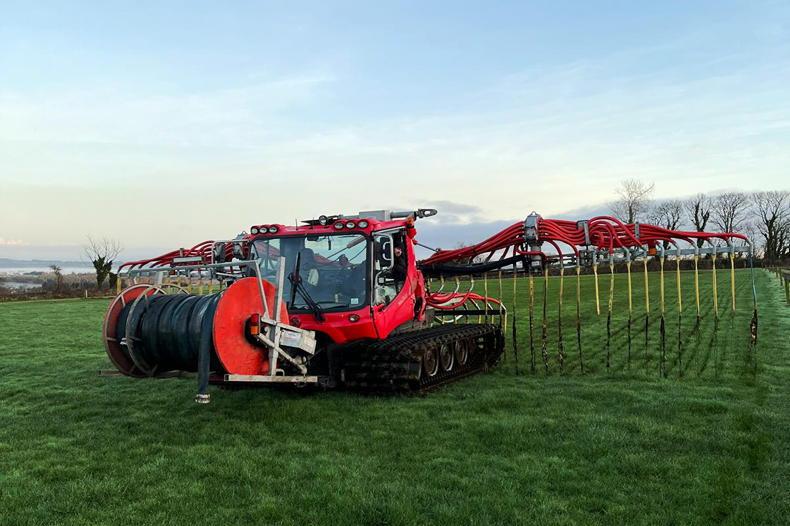Two years since its official unveiling at Agritechnica in Germany, the first of Strautmann’s latest Magnon forage wagon range has made its way to Irish shores. The three-model 42m3-52m3 range replaces the firm’s current 40m3-50m3 Tera-Vitesse, flagship range.
The new Magnon line-up brings with it an overdue facelift in the styling department, probably the most notable since the 1980s. There has been a number of other updates too.
The most obvious change is the arrival of the moving headboard, something all the major manufacturers have adopted in recent years since Lely started the trend in 2013.
Other major changes include the new Exact-Cut chopping unit and possibly the most highly anticipated of the lot, the move away from the traditional spring type pickup tine to a flexible plastic finger type.
However, Strautmann has bucked the current trend of not going down the sloped-floor route, something most of the major players have done in the last number of years with high-capacity wagons, Pöttinger being the latest.
We caught up with Irish importer, IAM Agricultural Machinery’s demonstration CFS 430 model working alongside its predecessor, a Tera-Vitesse CFS 4201 in Kildare.
Pickup
The Magnon is equipped with a 2.25m wide camless pickup reel which sees six rows of the firm’s new flexible plastic pickup tines which are configured in a similar chevron pattern to before.
These 10mm wide tines give a strong, chunkier look to the pickup compared to the conventional spring tine. However, it’s not all about looks. The new plastic tine is said to reduce contamination and adapt to ground conditions better.
Gone are the not so favourable days of removing bands to replace tines, instead a tine sits into a keeper plate fastened with a single bolt – replacement can be done in less than a minute.
The manufacturer claims a longer service life with its new tine design, but only time will tell. What we do like is that tines simply bend back under pressure from a foreign object and do not build pressure like a conventional spring tine.
There was no issue at all lifting 20ft rows of second-cut grass at a steady 8km/h, what we did notice was the notably silent operation of the pickup
The pickup is now hydraulically driven instead of chain driven. Not only does this reduce maintenance but now pickup speed can be set to speed up/ slow down in accordance with the tractor’s forward speed via wheel speed sensor. The slim drawbar allows for great visibility of the pickup.
CFS and rotor
First introduced in 2010, the Strautmann Continuous Flow System (CFS) is a key selling point for the majority of the firm’s pickups.
Sitting between the pickup reel and rotor, the CFS is there to both accelerate and disperse crop across the entire width of the pickup, similar to how a combine header auger works but only in reverse.
Strautmann says that its CFS helps maintain a higher main rotor position and therefore a reduced power requirement.
This is why the firm says it doesn’t need a sloping floor and that its own in-house testing on the sloped concept actually required more power to drive rather than less.
Its feed principle is similar to that of a square baler. Grass is fed straight up and compressed before being moved back via floor chains, similar to a plunger of a square baler. This differs to the sloping floor concept which is comparable to an open throat. This, the firm claims from its own testing, would leave the forage needing to be pushed back as well as upwards as it leaves the rotor and thus requires a greater drive.
The rotor is 2.1m wide (1.74m feed width) and 840mm in diameter with eight rows of 17mm-wide tines in a helical configuration.
To the left and right and side of the rotor are 17.5cm integral augers to help direct the crop into the feed area. Rotor tines and strippers are arranged at a large angle to each other, with a Hardox face on each stripper for anti-wear protection. The rotor drive is kept simple via planetary gearbox integrated into the rotor shaft.
Knife bank
The new Exact-Cut knife bank was launched around the time of the Magnon. However, we have seen this system on some of the Tera models since. Its 48 reversible knives provide a theoretical chop length of 35mm.
Each knife has its own protection system. The new system retracts its knives once required using a concept similar to that of a knee joint.
Rubber stops instead of springs maintain the levers in a beyond dead point position. So, for example a stone makes its way into the knife bank, the knife or knives completely retract and the spring is tensioned.
When the object has passed, the spring automatically retracts the knife/knives into working position.
The idea here is to ensure that a small area of the blade is affected by the foreign object and not the whole edge. Tripping force is adjustable.
Strautmann felt that wear points and pivot points had to be kept to a minimum within the chopping unit if it is to maintain a precise chop. Therefore the chopping unit does not swing out of the machine for maintenance purposes like its competitors.
However, knives are still quite easily accessed for maintenance purposes once lowered and the front end of the wagon raised on the drawbar.
Blades are easily removed using the tool provided.
Moving headboard
The moving headboard is designed to aid both loading and unloading as well as increase carrying capacity. The headboard position during loading can be set at any angle depending on the level of compression required.
Once nearing full, the headboard pivots back towards the tractor and creates a further 5m3 of space. The design has allowed capacities to be increased while the overall length of the three models has decreased slightly in comparison to their equivalent Tera model.
In automatic loading mode, the wagon lowers its drawbar ready for the PTO to be engaged. As grass then reaches the load protection bars on the headboard and compression settings are reached, the floor chains move as they need to.
There is no torque sensor like on some of the competitor machines. Each of the floor chains has a breaking strength of 12t while the floor itself is made from galvanised steel sheeting. The single centralised gearbox driving the floor chains on the Tera models is now replaced by twin hydraulic motors.
While unloading, the headboard pivots automatically backwards to speed up the unloading cycle by pushing the forage backwards.
Controls and loading
The unit we saw was fitted with the Smart 570 5.7in control terminal, the only terminal option available aside from ditching the terminal and going full Isobus.
It is a more modern terminal to that found in its predecessors, although a nice bit smaller to what some of the competitors offer.
There are separate screens dedicated to road, fill and unloading modes. Each screen has a host of the associated buttons for that particular mode.
As standard, Strautmann has added an external keypad on the pickup side panel for external operation of the drawbar and chopping unit, leaving the task of working with the knife bank easier.
Also as standard, the three Magnon models are fitted with both forced steering and a hydraulic axle suspension.
Customers can also opt for the usual extra features which include a folding mesh cover, LED interior and exterior lights as well as a camera system. Rear discharge beaters are also an option. However, they are not that applicable to the Irish market.
Machine spec
Model: Magnon CFS 430Capacity: 42m3 Pickup: 2.25m camless, hydraulic drive Knives: 48 double sidedChop length: 35mm theoreticalUnladen weight: 11.1tList Price: €000,000 Plus VAT
Two years since its official unveiling at Agritechnica in Germany, the first of Strautmann’s latest Magnon forage wagon range has made its way to Irish shores. The three-model 42m3-52m3 range replaces the firm’s current 40m3-50m3 Tera-Vitesse, flagship range.
The new Magnon line-up brings with it an overdue facelift in the styling department, probably the most notable since the 1980s. There has been a number of other updates too.
The most obvious change is the arrival of the moving headboard, something all the major manufacturers have adopted in recent years since Lely started the trend in 2013.
Other major changes include the new Exact-Cut chopping unit and possibly the most highly anticipated of the lot, the move away from the traditional spring type pickup tine to a flexible plastic finger type.
However, Strautmann has bucked the current trend of not going down the sloped-floor route, something most of the major players have done in the last number of years with high-capacity wagons, Pöttinger being the latest.
We caught up with Irish importer, IAM Agricultural Machinery’s demonstration CFS 430 model working alongside its predecessor, a Tera-Vitesse CFS 4201 in Kildare.
Pickup
The Magnon is equipped with a 2.25m wide camless pickup reel which sees six rows of the firm’s new flexible plastic pickup tines which are configured in a similar chevron pattern to before.
These 10mm wide tines give a strong, chunkier look to the pickup compared to the conventional spring tine. However, it’s not all about looks. The new plastic tine is said to reduce contamination and adapt to ground conditions better.
Gone are the not so favourable days of removing bands to replace tines, instead a tine sits into a keeper plate fastened with a single bolt – replacement can be done in less than a minute.
The manufacturer claims a longer service life with its new tine design, but only time will tell. What we do like is that tines simply bend back under pressure from a foreign object and do not build pressure like a conventional spring tine.
There was no issue at all lifting 20ft rows of second-cut grass at a steady 8km/h, what we did notice was the notably silent operation of the pickup
The pickup is now hydraulically driven instead of chain driven. Not only does this reduce maintenance but now pickup speed can be set to speed up/ slow down in accordance with the tractor’s forward speed via wheel speed sensor. The slim drawbar allows for great visibility of the pickup.
CFS and rotor
First introduced in 2010, the Strautmann Continuous Flow System (CFS) is a key selling point for the majority of the firm’s pickups.
Sitting between the pickup reel and rotor, the CFS is there to both accelerate and disperse crop across the entire width of the pickup, similar to how a combine header auger works but only in reverse.
Strautmann says that its CFS helps maintain a higher main rotor position and therefore a reduced power requirement.
This is why the firm says it doesn’t need a sloping floor and that its own in-house testing on the sloped concept actually required more power to drive rather than less.
Its feed principle is similar to that of a square baler. Grass is fed straight up and compressed before being moved back via floor chains, similar to a plunger of a square baler. This differs to the sloping floor concept which is comparable to an open throat. This, the firm claims from its own testing, would leave the forage needing to be pushed back as well as upwards as it leaves the rotor and thus requires a greater drive.
The rotor is 2.1m wide (1.74m feed width) and 840mm in diameter with eight rows of 17mm-wide tines in a helical configuration.
To the left and right and side of the rotor are 17.5cm integral augers to help direct the crop into the feed area. Rotor tines and strippers are arranged at a large angle to each other, with a Hardox face on each stripper for anti-wear protection. The rotor drive is kept simple via planetary gearbox integrated into the rotor shaft.
Knife bank
The new Exact-Cut knife bank was launched around the time of the Magnon. However, we have seen this system on some of the Tera models since. Its 48 reversible knives provide a theoretical chop length of 35mm.
Each knife has its own protection system. The new system retracts its knives once required using a concept similar to that of a knee joint.
Rubber stops instead of springs maintain the levers in a beyond dead point position. So, for example a stone makes its way into the knife bank, the knife or knives completely retract and the spring is tensioned.
When the object has passed, the spring automatically retracts the knife/knives into working position.
The idea here is to ensure that a small area of the blade is affected by the foreign object and not the whole edge. Tripping force is adjustable.
Strautmann felt that wear points and pivot points had to be kept to a minimum within the chopping unit if it is to maintain a precise chop. Therefore the chopping unit does not swing out of the machine for maintenance purposes like its competitors.
However, knives are still quite easily accessed for maintenance purposes once lowered and the front end of the wagon raised on the drawbar.
Blades are easily removed using the tool provided.
Moving headboard
The moving headboard is designed to aid both loading and unloading as well as increase carrying capacity. The headboard position during loading can be set at any angle depending on the level of compression required.
Once nearing full, the headboard pivots back towards the tractor and creates a further 5m3 of space. The design has allowed capacities to be increased while the overall length of the three models has decreased slightly in comparison to their equivalent Tera model.
In automatic loading mode, the wagon lowers its drawbar ready for the PTO to be engaged. As grass then reaches the load protection bars on the headboard and compression settings are reached, the floor chains move as they need to.
There is no torque sensor like on some of the competitor machines. Each of the floor chains has a breaking strength of 12t while the floor itself is made from galvanised steel sheeting. The single centralised gearbox driving the floor chains on the Tera models is now replaced by twin hydraulic motors.
While unloading, the headboard pivots automatically backwards to speed up the unloading cycle by pushing the forage backwards.
Controls and loading
The unit we saw was fitted with the Smart 570 5.7in control terminal, the only terminal option available aside from ditching the terminal and going full Isobus.
It is a more modern terminal to that found in its predecessors, although a nice bit smaller to what some of the competitors offer.
There are separate screens dedicated to road, fill and unloading modes. Each screen has a host of the associated buttons for that particular mode.
As standard, Strautmann has added an external keypad on the pickup side panel for external operation of the drawbar and chopping unit, leaving the task of working with the knife bank easier.
Also as standard, the three Magnon models are fitted with both forced steering and a hydraulic axle suspension.
Customers can also opt for the usual extra features which include a folding mesh cover, LED interior and exterior lights as well as a camera system. Rear discharge beaters are also an option. However, they are not that applicable to the Irish market.
Machine spec
Model: Magnon CFS 430Capacity: 42m3 Pickup: 2.25m camless, hydraulic drive Knives: 48 double sidedChop length: 35mm theoreticalUnladen weight: 11.1tList Price: €000,000 Plus VAT 









SHARING OPTIONS